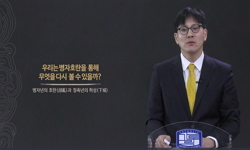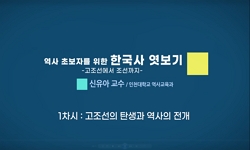Examined in this article is how the general perception of the Gwan’wang-myo altars changed during the latter half of the Joseon dynasty period, and what is the meaning of that change. During the war with the Japanese, and especially during the secon...
http://chineseinput.net/에서 pinyin(병음)방식으로 중국어를 변환할 수 있습니다.
변환된 중국어를 복사하여 사용하시면 됩니다.
- 中文 을 입력하시려면 zhongwen을 입력하시고 space를누르시면됩니다.
- 北京 을 입력하시려면 beijing을 입력하시고 space를 누르시면 됩니다.

조선후기 관왕묘(關王廟)에 대한 인식의 전환과 그 의미 = Changes in the perspective viewing the Gwan’wang-myo(關王廟) altars, in the latter half of the Joseon period
한글로보기https://www.riss.kr/link?id=A102075238
- 저자
- 발행기관
- 학술지명
- 권호사항
-
발행연도
2016
-
작성언어
Korean
- 주제어
-
KDC
900
-
등재정보
KCI등재
-
자료형태
학술저널
- 발행기관 URL
-
수록면
271-305(35쪽)
- 제공처
- 소장기관
-
0
상세조회 -
0
다운로드
부가정보
다국어 초록 (Multilingual Abstract)
Before the establishment of these altars, the Joseon public only considered the Gwan’u figure as one that came out of history books, and did not think of him in any special meaning. During the war with the Japanese troops at the end of the 16<SUP>th</SUP> century, certain folk beliefs of this Gwan’u figure, which originated in China to revere Gwan’u as a god-like figure, had spreaded over to the Korean peninsula. Gwan’wang-myo altars were erected not only in the capital city but also in several local regions. They were never erected at the Joseon government’s will, and had nothing to do with the Joseon public’s stance toward him. Even in the second half of the 17<SUP>th</SUP> century, these altars were still perceived with an image associated with several unpleasant memories of the recent two horrific wars, as well as the unstable foreign conditions of the time. As a result, the Joseon leaders had fairly negative views of these altars.
This kind of negative view began to change in the 18<SUP>th</SUP> century. Kings frequently visited these altars and paid respect, and the Gwan’wang-myo altar service itself was even added to the official roster of dynastic memorial rituals. This was primarily because the Joseon government needed them in their efforts to display its own resolve to maintain its very loyalty toward the fallen Ming dynasty, through their promotion of the Gwan’wang-myo altars which Ming troops had earlier established. The Joseon government also did so because it had to demonstrate its own will to stay true to the traditional Confucian notion of ‘inheriting the predecessor’s honorary task and succeeding the will behind it’ too[繼志述事] and the favor of rebuilding the country by Ming[再造之恩]. So, this sort of new promotion of the altars themselves were actually born out of the Joseon kings’ intentions to essentially rekindle the public’s memories of Ming. Ironically, their promotion of the Gwan’u belief was very much similar to how it was being done in Qing, the very aggressor which defeated Ming in the first place.
In short, the Gwan’wang-myo altars were considered by the Joseon kings as a memorial ground for the fallen Ming dynasty. It was also viewed as an adequate place for them to hold memorial services, as the figure in question, Gwan’u, was sort of a symbolic figure of loyalty and the act of honoring him could create a certain political atmosphere that would be most helpful to the kings in solidifying their own authority and leadership.
Examined in this article is how the general perception of the Gwan’wang-myo altars changed during the latter half of the Joseon dynasty period, and what is the meaning of that change. During the war with the Japanese, and especially during the second phase that began in the Jeong’yu-year(1597), the Ming army which came to help Joseon established Gwan’wang-myo altars here and there throughout the Korean peninsula. This was at the end of the 16th century, and later, coming into the 18th century the public’s view of these altars hugely changed.
Before the establishment of these altars, the Joseon public only considered the Gwan’u figure as one that came out of history books, and did not think of him in any special meaning. During the war with the Japanese troops at the end of the 16<SUP>th</SUP> century, certain folk beliefs of this Gwan’u figure, which originated in China to revere Gwan’u as a god-like figure, had spreaded over to the Korean peninsula. Gwan’wang-myo altars were erected not only in the capital city but also in several local regions. They were never erected at the Joseon government’s will, and had nothing to do with the Joseon public’s stance toward him. Even in the second half of the 17<SUP>th</SUP> century, these altars were still perceived with an image associated with several unpleasant memories of the recent two horrific wars, as well as the unstable foreign conditions of the time. As a result, the Joseon leaders had fairly negative views of these altars.
This kind of negative view began to change in the 18<SUP>th</SUP> century. Kings frequently visited these altars and paid respect, and the Gwan’wang-myo altar service itself was even added to the official roster of dynastic memorial rituals. This was primarily because the Joseon government needed them in their efforts to display its own resolve to maintain its very loyalty toward the fallen Ming dynasty, through their promotion of the Gwan’wang-myo altars which Ming troops had earlier established. The Joseon government also did so because it had to demonstrate its own will to stay true to the traditional Confucian notion of ‘inheriting the predecessor’s honorary task and succeeding the will behind it’ too[繼志述事] and the favor of rebuilding the country by Ming[再造之恩]. So, this sort of new promotion of the altars themselves were actually born out of the Joseon kings’ intentions to essentially rekindle the public’s memories of Ming. Ironically, their promotion of the Gwan’u belief was very much similar to how it was being done in Qing, the very aggressor which defeated Ming in the first place.
In short, the Gwan’wang-myo altars were considered by the Joseon kings as a memorial ground for the fallen Ming dynasty. It was also viewed as an adequate place for them to hold memorial services, as the figure in question, Gwan’u, was sort of a symbolic figure of loyalty and the act of honoring him could create a certain political atmosphere that would be most helpful to the kings in solidifying their own authority and leadership.
목차 (Table of Contents)
- 머리말
- 1. 17세기 이전 관우 인식과 관왕묘 건립
- 2. 18세기 관왕묘에 대한 인식의 전환
- 맺음말
- 참고문헌
- 머리말
- 1. 17세기 이전 관우 인식과 관왕묘 건립
- 2. 18세기 관왕묘에 대한 인식의 전환
- 맺음말
- 참고문헌
- Abstract
동일학술지(권/호) 다른 논문
-
[총론] 당대(唐代) 묘지명을 통해 본 고구려·백제 유민(遺民) 일족(一族)의 동향
- 한국역사연구회
- 안정준
- 2016
- KCI등재
-
당대(唐代) 묘지명에 나타난 중국 기원(起源) 고구려 유민(遺民) 일족(一族)의 현황과 그 가계(家系) 기술
- 한국역사연구회
- 안정준(An, Jeong-jun)
- 2016
- KCI등재
-
- 한국역사연구회
- 최상기(Choi, Sang-ki)
- 2016
- KCI등재
-
당의 고구려 고지(故地) 지배 방식과 유민(遺民)의 대응
- 한국역사연구회
- 장병진(Jang, Byung-jin)
- 2016
- KCI등재





 DBpia
DBpia





